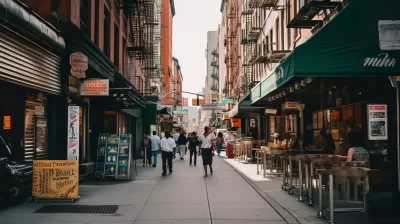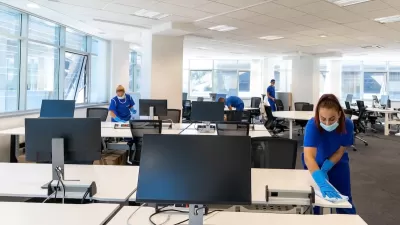While office vacancies remain high and foot traffic sparse in many U.S. downtowns, areas with housing and businesses are more vibrant and desirable than ever.

The rise of remote work during the Covid-19 pandemic has indeed shifted the center of gravity for U.S. cities, but rather than the wholesale ‘death of cities’ predicted early on, this change has simply meant that neighborhoods with mixed-use amenities are thriving while sterile, 9-to-5 business districts flounder.
Konrad Putzier and Kate King outline the phenomenon in The Wall Street Journal, writing, “Many residential neighborhoods benefit from remote work. As people spend more time at home, they frequent local shops, gyms and restaurants, boosting the economy of places such as Brooklyn, N.Y.’s Ditmas Park and Williamsburg, as well as Washington, D.C.’s Georgetown.”
Data shows visitor foot traffic is quickly rebounding to pre-pandemic levels in mixed-use, residential neighborhoods, while downtown foot traffic remains low. “Rent data, meanwhile, attests to strong demand for city living,” with rents significantly higher in desirable neighborhoods. “In the Brentwood neighborhood of Los Angeles, the median rent is up 63%.”
The authors don’t deny the challenges facing cities. “Vacant office buildings leave downtown shops and restaurants with too few customers, while falling commercial building values threaten property-tax revenues,” while “Housing shortages have pushed up rents.” But the neighborhoods with the characteristics and amenities most valued before the pandemic—walkability, access to transit, and a mix of businesses and residential uses—are continuing to draw residents eager to live there.
FULL STORY: American Cities Are Starting to Thrive Again. Just Not Near Office Buildings.

Alabama: Trump Terminates Settlements for Black Communities Harmed By Raw Sewage
Trump deemed the landmark civil rights agreement “illegal DEI and environmental justice policy.”

Study: Maui’s Plan to Convert Vacation Rentals to Long-Term Housing Could Cause Nearly $1 Billion Economic Loss
The plan would reduce visitor accommodation by 25% resulting in 1,900 jobs lost.

Why Should We Subsidize Public Transportation?
Many public transit agencies face financial stress due to rising costs, declining fare revenue, and declining subsidies. Transit advocates must provide a strong business case for increasing public transit funding.

Wind Energy on the Rise Despite Federal Policy Reversal
The Trump administration is revoking federal support for renewable energy, but demand for new projects continues unabated.

Passengers Flock to Caltrain After Electrification
The new electric trains are running faster and more reliably, leading to strong ridership growth on the Bay Area rail system.

Texas Churches Rally Behind ‘Yes in God’s Back Yard’ Legislation
Religious leaders want the state to reduce zoning regulations to streamline leasing church-owned land to housing developers.
Urban Design for Planners 1: Software Tools
This six-course series explores essential urban design concepts using open source software and equips planners with the tools they need to participate fully in the urban design process.
Planning for Universal Design
Learn the tools for implementing Universal Design in planning regulations.
Caltrans
Smith Gee Studio
Institute for Housing and Urban Development Studies (IHS)
City of Grandview
Harvard GSD Executive Education
Toledo-Lucas County Plan Commissions
Salt Lake City
NYU Wagner Graduate School of Public Service




























